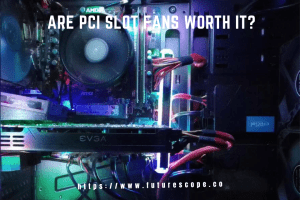What We Have Covered in This Article
Last Updated on September 29, 2022 by Editor Futurescope
If you have recently embarked into the world of PCs, you may ask yourself if you can fit Micro-ATX into an ATX case. If that’s the case, worry less. This article takes the stress out of your back to give you the answer to your question.
Yes, you can fit a Micro-ATX into an ATX case. The fitting may look weird at first, but it will seem normal after some time. Far from looks, the performance of the Micro-ATX won’t be affected as it will function normally. Additionally, the fitting comes with various advantages.
Are you ready to fit the Micro ATX into an ATX case? If yes, keep reading this post to discover how the two are linked and their advantages.
What are Micro-ATX and ATX Cases?
The Micro-ATX is a small motherboard that saves on space and energy consumption. A Micro-ATX board is about 9.6 by 9.6 inches in maximum size. Compared to the ATX motherboard, it is cheaper but has less storage capacity.
There is a key difference between ATX and Micro-ATX. The ATX has seven Peripheral Component Interconnect Express (PCIe) slots while Micro-ATX has four. However, both have an equal number of RAM slots which is four.
ATX Case or the Mid-tower is the most utilized motherboard. It measures 35-55 cm in height and 15-25 cm in width. Users of the ATX Case enjoy the adequate space present, and you can put up to 300 mm long video cards in the ATX Case. Further, it has a capacity of 120-200 mm fans.
Compatibility of Micro-ATX and ATX Case
The two ATX types are physically compatible since they share similar mounting holes as large-size ATX boards. Only the bottom level of the large-size ATX levels differ from these two since they are shorter.
Most mid and full-tower ATX cases have the right standoff mounts for Micro-ATX. In case yours lacks, worry less as there are six mounting holes between ATX and Micro-ATX. Therefore, you shouldn’t encounter any problems when mounting.
Expansion slots in the right place should be the least of your worries. The top PCIe x16 slot is always at the same point despite the motherboard’s size. The positioning of the PCIe allows the reaching of the mounting slots, even if the motherboard is small.
Do You Need to Buy an ATX-Case for Micro ATX?
Buying a PC case bigger than your motherboard is a good idea. If you want to utilize a Micro ATX motherboard, purchase an ATX case.
From this, you will get extra space for the motherboard, the case won’t fully occupy the inside, and there will be minimal possibilities of overheating. However, there is a disadvantage that arises when using a larger casing. People who prioritize keeping the motherboard short should use the exact motherboard casing, not a larger one.
When you are in the PC shop and come across the terms mid and full tower cases, don’t scratch your head about them. The terms represent the sizes of the ATX cases. The mid-tower cases are suitable for ATX motherboards and smaller ones, while the Full tower cases can take any size of motherboard.
Advantages and Disadvantages of Using a Micro ATX motherboard in an ATX Case
As stated earlier in the article, some pros and cons are present when using the ATX case. The following are the pros associated with the ATX case:
Long-lasting
Using the Micro ATX case implies that you have limited space and can only increase the space by purchasing a new case. The downside is the new case you purchase comes with another motherboard you may not require. This change causes the process of upgrades to be expensive. This movement means you’ll waste time transplanting the motherboard into the new case.
Avoid those unnecessary costs by buying a larger case from the start. In case you need to buy a PC case, then think about whether you will upgrade. So if you see that sooner, you will upgrade; just buy a full-tower case as it will account for all your needs with no problems.
Cost
Sometimes you may have an ATX case and lack a motherboard. For this, you are to purchase a Micro ATX motherboard. The reason is that M-ATX motherboards are cheaper than the ATX motherboard.
Although an M-ATX motherboard may compete with ATX in price, some are cheaper, such as the Gigabyte B450 motherboard. It may be old and not as durable, but it costs $30 less than the B450 ATX motherboard. This motherboard will at least save you something in the shop.
The ATX case is not the only option if you stick to connecting one device, but if you want to sync more devices, use an ATX case. The ATX case has more PCIe slots which may be suitable for you.
The Disadvantage is the Aesthetics
The Micro-ATX is smaller than the ATX case by about 2.4 inches which may cause differences because of the case. This may either be a total bother or no problem at all.
This won’t be noticeable for a modern ATX case with a black interior. It’s not easy to overlook the ATX case without the PSU shrouds, making the build look low quality.
Comparing the pros and cons, the aesthetic should not be a reason for not purchasing the ATX case.
Can the microATX Motherboard Fit In ATX Case?
So, the answer? Yes. A microATX motherboard can fit inside an ATX case. It can even fit inside an EATX case.
The rule with motherboards and their required case size is that every motherboard can fit inside it’s corresponding case size, and every size above it.
Final Thoughts
Buying an ATX case for your Micro ATX motherboard is a good idea that will serve you well and for a long time. The ATX case that contains more ports for connecting more devices minimizes the time taken for device transfer.
Additionally, the effectiveness and performance of the ATX cases are guaranteed; hence you shouldn’t worry.









